Themed collection In Celebration of David Cole-Hamilton's Career in Chemistry

An appreciation of Professor David Cole-Hamilton
It has been my privilege and pleasure to have been a friend of David Cole-Hamilton over many years. This Editorial provides a review of his research contributions.

Dalton Trans., 2013
https://doi.org/10.1039/C3DT90069J
David Cole-Hamilton – the perfect academic
It is with the greatest of pleasure that we recognise David Cole-Hamilton's many accomplishments with this special Commemorative issue.

Dalton Trans., 2013
https://doi.org/10.1039/C3DT90068A
Preparation of materials in the presence of hydrogen peroxide : from discrete or “zero-dimensional” objects to bulk materials
A short overview of synthetic methods using H2O2 and/or peroxidic species for the elaboration of discrete or zero-dimensional species, as well as mono-, bi- and tri-dimensional materials is presented.
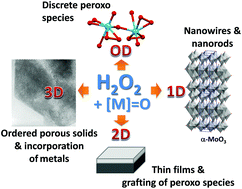
Dalton Trans., 2013,42, 29-45
https://doi.org/10.1039/C2DT31660A
Single source molecular precursor routes to lead chalcogenides
The use of single-source molecular precursors for lead chalcogenide thin films by CVD or as nanoparticles by solution methods is reviewed.
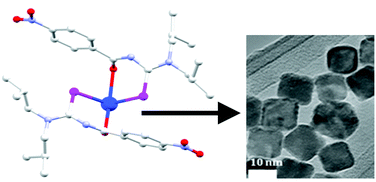
Dalton Trans., 2012,41, 10497-10506
https://doi.org/10.1039/C2DT30849E
Copper/TEMPO catalysed synthesis of nitriles from aldehydes or alcohols using aqueous ammonia and with air as the oxidant
A safe and readily accessible method for the aerobic catalytic synthesis of nitriles from aldehydes or alcohols.
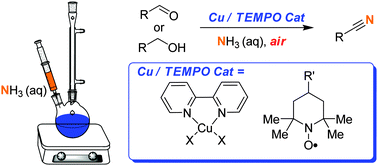
Chem. Commun., 2013,49, 6030-6032
https://doi.org/10.1039/C3CC42231C
Cyclic decapeptide gramicidin S derivatives containing phosphines : novel ligands for asymmetric catalysis
The cyclic peptide gramicidin S was used as a template for the construction of novel peptide-based bisphosphine ligands for asymmetric transition metal catalysis.
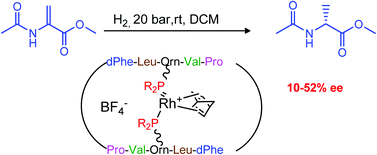
Dalton Trans., 2013,42, 1973-1978
https://doi.org/10.1039/C2DT31782F
Carbon monoxide and carbon dioxide insertion chemistry of f-block N-heterocyclic carbene complexes
The f-block complexes ([M(L)(N{SiMe3}2)2] L = bidentate alkoxy-tethered NHC ligand) with CO and CO2, COS and N2CPh2 show to [M(L)2(N{SiMe3}2)], show much more varied insertion chemistry than [M(N{SiMe3}2)3].
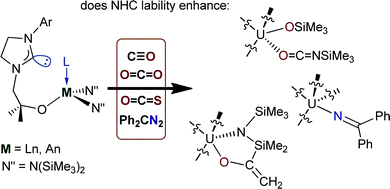
Dalton Trans., 2013,42, 1333-1337
https://doi.org/10.1039/C2DT31698F
Simplifying the conductance profiles of molecular junctions: the use of the trimethylsilylethynyl moiety as a molecule–gold contact
The trimethylsilylethynyl moiety, –C![[triple bond, length as m-dash]](https://www.rsc.org/images/entities/char_e002.gif) CSiMe3, is shown to act as an effective contact in Au|molecule|Au junctions.
CSiMe3, is shown to act as an effective contact in Au|molecule|Au junctions.
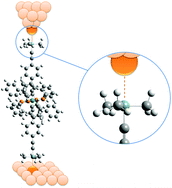
Dalton Trans., 2013,42, 338-341
https://doi.org/10.1039/C2DT31825C
Co-crystallisation of competing structural modes in geometrically constrained Jahn–Teller manganese(III) complexes
The combination of Jahn–Teller distortion and chelating ligands produces a fine balance between competing coordination modes in manganese(III) resulting in well-ordered co-crystallization of two distinct assemblies from one set of components under a single set of conditions.

Dalton Trans., 2012,41, 14487-14489
https://doi.org/10.1039/C2DT31742G
Ethylene /allyl monomer cooligomerization by nickel/phosphine–sulfonate catalysts
Nickel(II) complexes bearing a phosphine–sulfonate ligand, [(R2PC6H4SO3)NiMe(2,6-lutidine)] (R = cyclohexyl, 2-MeOC6H4, and 2-[2′,6′-(MeO)2C6H3]C6H4, were synthesized and applied as catalysts for the cooligomerizations of ethylene and allyl monomers.

Dalton Trans., 2012,41, 13807-13809
https://doi.org/10.1039/C2DT31771K
Green production of polymer -supported PdNPs: application to the environmentally benign catalyzed synthesis of cis-3-hexen-1-ol under flow conditions
Polymer-supported PdNPs: from batch to continuous synthesis of fine chemicals.
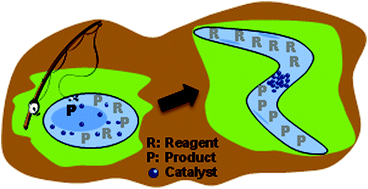
Dalton Trans., 2012,41, 12666-12669
https://doi.org/10.1039/C2DT31626A
Cyclometallation of arylimines and nitrogen-containing heterocycles via room-temperature C–H bond activation with arene ruthenium(II) acetate complexes
The synthesis of stable imine (N^C)-cyclometallated ruthenium(II) complexes via C–H bond activation/deprotonation is described from the reaction of [RuCl2(p-cymene)]2, arylimines and KOAc in methanol at r.t.
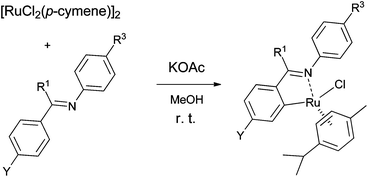
Dalton Trans., 2012,41, 10934-10937
https://doi.org/10.1039/C2DT31401K
Convenient and improved protocols for the hydrogenation of esters using Ru catalysts derived from (P,P), (P,N,N) and (P,N,O) ligands
Several active catalysts have been identified and applied in the hydrogenation of aromatic esters at temperatures as low as 30 °C.
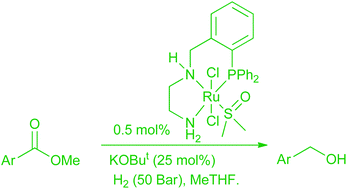
Dalton Trans., 2012,41, 10136-10140
https://doi.org/10.1039/C2DT30973D
Phosphate binding to the [Au(IPr)] moiety: inner vs. outer sphere coordination behaviour
The synthesis and characterization of a new class of cationic (NHC)gold(I) (NHC = N-Heterocyclic carbene) complexes containing the phosphate counterions TRISPHAT and TRISPHAT-N have been achieved.
![Graphical abstract: Phosphate binding to the [Au(IPr)] moiety: inner vs. outer sphere coordination behaviour](/en/Image/Get?imageInfo.ImageType=GA&imageInfo.ImageIdentifier.ManuscriptID=C2DT30440F&imageInfo.ImageIdentifier.Year=2012)
Dalton Trans., 2012,41, 8235-8237
https://doi.org/10.1039/C2DT30440F
Synthesis of mesoporous silica nanobamboo with highly dispersed tungsten carbide nanoparticles
Mesoporous silica nanobamboo with highly dispersed WC nanoparticles was synthesized by tuning the interaction between ammonium metatungstate and cetyltrimethylammonium bromide micelles.
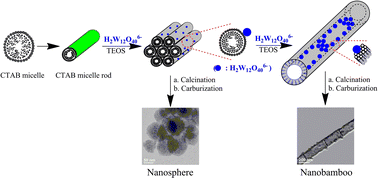
Dalton Trans., 2012,41, 6914-6918
https://doi.org/10.1039/C2DT30248A
Synthetic routes to [Au(NHC)(OH)] (NHC = N-heterocyclic carbene ) complexes
New procedures for the synthesis of [Au(NHC)(OH)] are reported.
![Graphical abstract: Synthetic routes to [Au(NHC)(OH)] (NHC = N-heterocyclic carbene) complexes](/en/Image/Get?imageInfo.ImageType=GA&imageInfo.ImageIdentifier.ManuscriptID=C2DT30294B&imageInfo.ImageIdentifier.Year=2012)
Dalton Trans., 2012,41, 5461-5463
https://doi.org/10.1039/C2DT30294B
Reactivity of Ir(III) carbonyl complexes with water: alternative by-product formation pathways in catalytic methanol carbonylation
The unexpected reactivity towards water of an iridium acetyl complex points towards alternative by-product formation pathways in Ir-catalysed methanol carbonylation.

Dalton Trans., 2013,42, 16538-16546
https://doi.org/10.1039/C3DT52092G
An investigation of crystal structure, surface area and surface chemistry of strontium niobate and their influence on photocatalytic performance
Sr1−xNbO3 is an unusual material that displays both metallic type conduction and photocatalytic activity, despite being an NbIV oxide, and it sustains photo-oxidation without degradation.
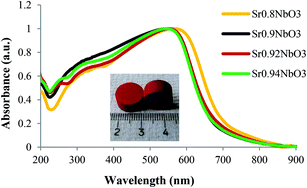
Dalton Trans., 2013,42, 7880-7887
https://doi.org/10.1039/C3DT32064B
Reactivity of the terminal oxo species ((tBu2PCH2SiMe2)2N)RhO
Unusual polarization of the Rh/O fragment of a (pincer)RhO molecule gives high reactivity towards the varied reagents CO, CO2, and H2.
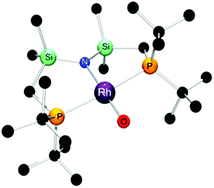
Dalton Trans., 2013,42, 6745-6755
https://doi.org/10.1039/C3DT31972E
Stability vs. reactivity: understanding the adsorption properties of Ni3(BTP)2 by experimental and computational methods
This article shows that Ni3(BTP)2 adopts a low spin configuration which does not interact strongly with CO, CO2, or H2.
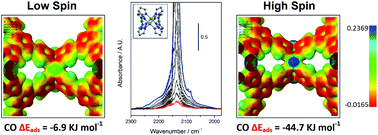
Dalton Trans., 2013,42, 6450-6458
https://doi.org/10.1039/C3DT32944E
Heterolytic activation of dihydrogen by platinum and palladium complexes
Under dihydrogen pressure, the pyridyl moiety of 2-(diphenylphosphino)pyridine can act as an internal base to assist the heterolytic cleavage of dihydrogen of platinum phosphine complexes.

Dalton Trans., 2013,42, 6495-6512
https://doi.org/10.1039/C3DT32395A
Catalyst recycling via specific non-covalent adsorption on modified silicas
This article describes a new strategy for the recycling of a homogeneous hydroformylation catalyst, by selective adsorption of the catalyst to tailor-made supports after a batchwise reaction.
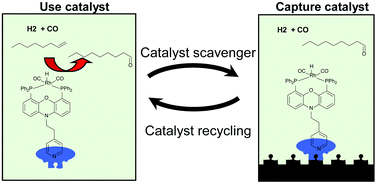
Dalton Trans., 2013,42, 3609-3616
https://doi.org/10.1039/C2DT32047A
The re-determination of the molecular structure of antimony(III) oxide using very-high-temperature gas electron diffraction (VHT–GED)
The molecular structure of antimony(III) oxide has been re-investigated utilising a new high-temperature nozzle system designed for the Canterbury (NZ) gas electron diffraction apparatus.
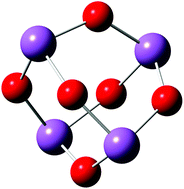
Dalton Trans., 2013,42, 3581-3586
https://doi.org/10.1039/C2DT32790B
Unexpected reversible pyrazine based methylation in a Ru(II) complex bearing a pyrazin-2′-yl-1,2,4-triazolato ligand and its effect on acid/base and photophysical properties
The reversible regioselective methylation of a ruthenium polypyridyl complex bearing both a 1,2,4-triazolato and a pyrazine moiety is reported.

Dalton Trans., 2013,42, 2546-2555
https://doi.org/10.1039/C2DT31589K
Formic acid dehydrogenation catalysed by ruthenium complexes bearing the tripodal ligands triphos and NP3
Ru(II) complexes bearing the polydentate ligands triphos and NP3 catalyse the dehydrogenation of formic acid to carbon dioxide and hydrogen at 80 °C in the presence of n-octyldimethylamine.
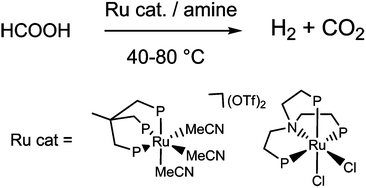
Dalton Trans., 2013,42, 2495-2501
https://doi.org/10.1039/C2DT32043F
Iron(II) and cobalt(II) complexes of tris-azinyl analogues of 2,2′:6′,2′′-terpyridine
Iron(II) and cobalt(II) complexes of seven different terpyridine analogues containing diazinyl or triazinyl heterocyclic donors have been prepared. The electrochemical properties of the complexes depend particularly strongly on the nitrogen content of the ligands.

Dalton Trans., 2013,42, 2254-2265
https://doi.org/10.1039/C2DT31736B
Sc(III) complexes with neutral N3- and SNS-donor ligands – a spectroscopic study of the activation of ethene polymerisation catalysts
Scandium NMR and XAFS studies of the reaction of [ScCl3(L3)] (L3 = R3-tacn and R-SNS tridentate ligands) show that MeLi causes methylation at Sc, whereas AlMe3 forms Sc–Cl–Al bridges.
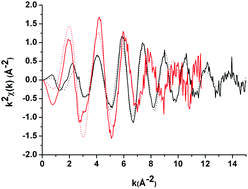
Dalton Trans., 2013,42, 2213-2223
https://doi.org/10.1039/C2DT31804K
Synthetic and computational study of geminally bis(supermesityl) substituted phosphorus compounds
Mes*2P(O)Cl is a highly sterically crowded compound whose reduction requires very harsh conditions. Resulting secondary phosphine (Mes*)(2,4-tBu2C6H3)PH is also very sterically encumbered. Synthetic and computational studies of this and other related crowded phosphorus species are reported.
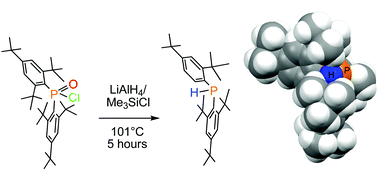
Dalton Trans., 2013,42, 1437-1450
https://doi.org/10.1039/C2DT31971C
Selective hydrogenation over Pd nanoparticles supported on a pore-flow-through silica monolith microreactor with hierarchical porosity
Pore-flow-through silica monoliths featuring a bimodal distribution of macropores (4 μm) and mesopores (11 nm) loaded with 6 nm Pd nanoparticles demonstrate remarkable stability of the activity for the continuous selective hydrogenation of 1,5-cyclooctadiene and 3-hexyn-1-ol.
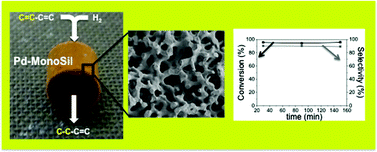
Dalton Trans., 2013,42, 1378-1384
https://doi.org/10.1039/C2DT31690K
Palladium -catalyzed asymmetric Heck arylation of 2,3-dihydrofuran – effect of prolinate salts
The phosphane-free catalytic system containing Pd(OAc)2 and chiral ionic liquids containing L-prolinate and L-lactate anions and non-chiral quaternary ammonium cations efficiently catalyzed regio- and stereoselective Heck arylation of 2,3-dihydrofuran with aryl iodides. Excellent enantioselectivity (>99% ee) was obtained in the reaction with tetrabutylammonium L-prolinate.

Dalton Trans., 2013,42, 1215-1222
https://doi.org/10.1039/C2DT31672B
Silver-catalyzed silicon–hydrogen bond functionalization by carbene insertion
The Si–H bonds of alkyl- aryl-substituted silanes have been functionalized using a silver-based catalyst for the carbene transfer reaction from diazocompounds.

Dalton Trans., 2013,42, 1191-1195
https://doi.org/10.1039/C2DT31460F
Synthesis and X-ray structures of cyclometalated iridium complexes including the hydrides
Cyclometalated iridium complexes are catalytically active and can be easily accessed.

Dalton Trans., 2013,42, 935-940
https://doi.org/10.1039/C2DT31368E
A computational study of the CO dissociation in cyclopentadienyl ruthenium complexes relevant to the racemization of alcohols
The formation of 16-electron ruthenium complexes via the loss of CO – an insight based on the potential energy profiles.
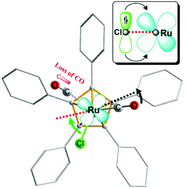
Dalton Trans., 2013,42, 927-934
https://doi.org/10.1039/C2DT31919E
Classical and non-classical phosphine-Ru(II)-hydrides in aqueous solutions: many, various, and useful
Governed by the pH and pressure, hydrogenation of [{RuCl2(mtppms)2}2] yields various classical and non-classical Ru(II)-hydrides exhibiting different catalytic properties in hydrogenation of unsaturated aldehydes.
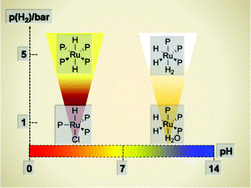
Dalton Trans., 2013,42, 521-529
https://doi.org/10.1039/C2DT31793A
On the influence of diphosphine ligands on the chemical order in small RuPt nanoparticles: combined structural and surface reactivity studies
Diphenylphosphinobutane (dppb) stabilized bimetallic RuPt nanoparticles were prepared by co-decomposition of [Ru(COD)(COT)] and [Pt(CH3)2(COD)] organometallic precursors under mild conditions and in the presence of dppb.
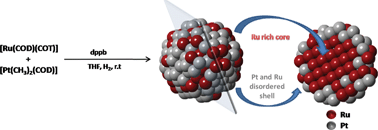
Dalton Trans., 2013,42, 372-382
https://doi.org/10.1039/C2DT31646C
Novel phospholyl(diphenylphosphino)methane-ruthenium complexes: unexpected non-assisted cis to trans isomerization of [RuCl2(κ2-P–P′)2]
The cis-[RuCl2(κ2-P–P′)2] complex containing the phospholyl(phosphino)methane ligand evolves very slowly at 20 °C into the trans-isomer, through decoordination of a phosphole arm.
![Graphical abstract: Novel phospholyl(diphenylphosphino)methane-ruthenium complexes: unexpected non-assisted cis to trans isomerization of [RuCl2(κ2-P–P′)2]](/en/Image/Get?imageInfo.ImageType=GA&imageInfo.ImageIdentifier.ManuscriptID=C2DT32032K&imageInfo.ImageIdentifier.Year=2013)
Dalton Trans., 2013,42, 75-81
https://doi.org/10.1039/C2DT32032K
Interplay of bite angle and cone angle effects. A comparison between o-C6H4(CH2PR2)(PR′2) and o-C6H4(CH2PR2)(CH2PR′2) as ligands for Pd-catalysed ethene hydromethoxycarbonylation
o-Diphosphinotoluenes produce Pd-catalysts for methoxycarbonylation of ethene with activities ranging from zero to the highest reported to date.
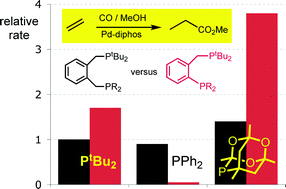
Dalton Trans., 2013,42, 100-115
https://doi.org/10.1039/C2DT31913F
Silver(I) coordination complexes and extended networks assembled from S, Se, Te substituted acenaphthenes
Chalcogen silver bonding leads to a range of coordination polymers depending on the nature of the chalcogen and the counterion.
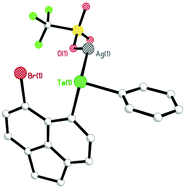
Dalton Trans., 2013,42, 143-154
https://doi.org/10.1039/C2DT31390A
Rh-catalyzed linear hydroformylation of styrene
An inversion of natural regioselectivity in the Rh-catalyzed hydroformylation of styrene to the linear product by introducing electron-withdrawing ligands.
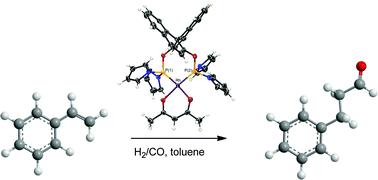
Dalton Trans., 2013,42, 137-142
https://doi.org/10.1039/C2DT31738A
Direct ‘in situ’, low VOC, high yielding, CO2 expanded phase catalytic chain transfer polymerisation : towards scale-up
The successful application of catalytic chain transfer polymerisation (CCTP) by adopting an ‘in situ’ catalyst preparation methodology in several polymerisation media is described.
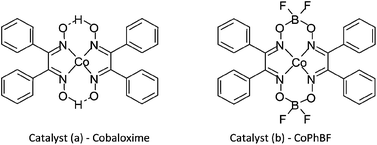
Dalton Trans., 2013,42, 127-136
https://doi.org/10.1039/C2DT31822A
An investigation on the second order nonlinear optical response of tris-cyclometallated Ir(III) complexes with variously substituted 2-phenylpyridines
Various simple tris-cyclometallated Ir(III) complexes are efficient second-order NLO chromophores with a response tunable by an appropriate substitution of 2-phenylpyridine ligands.
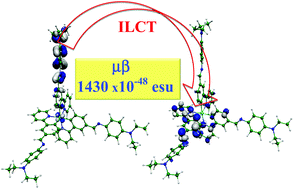
Dalton Trans., 2013,42, 155-159
https://doi.org/10.1039/C2DT31839C
Hydrogenation of quinolines , alkenes , and biodiesel by palladium nanoparticles supported on magnesium oxide
A new catalyst composed of Pd nanoparticles supported on MgO is efficient for the regioselective hydrogenation of quinolines, a variety of alkenes representative of fuel components, and the partial saturation of biodiesel.
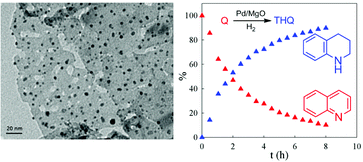
Dalton Trans., 2012,41, 14490-14497
https://doi.org/10.1039/C2DT31533E
Migratory insertion reactions of nickel and palladium σ-alkyl complexes with a phosphinito-imine ligand
The synthesis and migratory insertion reactions of σ-monoalkyl phosphinito-imine Ni and Pd complexes stabilized by a solvent molecule or intramolecular π-interactions are reported.
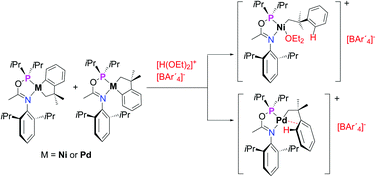
Dalton Trans., 2012,41, 14524-14539
https://doi.org/10.1039/C2DT31334K
Phosphorescent, liquid-crystalline complexes of platinum(II): influence of the β-diketonate co-ligand on mesomorphism and emission properties
The effect of β-diketonate co-ligands on the mesomorphism and photophysics of some di(alkoxyphenyl)pyridine complexes of platinum(II) is investigated.
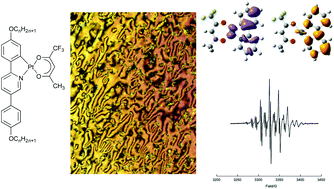
Dalton Trans., 2012,41, 14244-14256
https://doi.org/10.1039/C2DT31525D
Catalyzed hydrogenation of condensed three-ring arenes and their N-heteroaromatic analogues by a bis(dihydrogen) ruthenium complex
A comparative study on the catalyzed hydrogenation of linear three-ring aromatic hydrocarbons and their N-heteroaromatic analogues by ruthenium complexes is reported, with a specific focus on the influence of methyl substituents attached to the “external” and “internal” rings of the substrates.
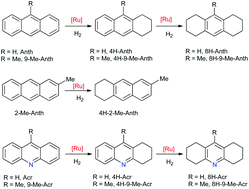
Dalton Trans., 2012,41, 14117-14125
https://doi.org/10.1039/C2DT31205K
Nitrosobenzene as a hydrogen acceptor in rhodium catalysed dehydrogenation reactions of alcohols: synthesis of aldehydes and azoxybenzenes
A diolefin Rh(I) amido catalyst converts efficiently a mixture of alcohols and nitrosoarenes to aldehydes and azoxyarenes.
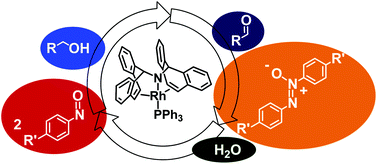
Dalton Trans., 2012,41, 14137-14145
https://doi.org/10.1039/C2DT31691A
Iridium(III) complexes with polypyridine ligands coordinated as N-heterocyclic carbenes . Synthesis, structure and photophysical properties
N-Heterocyclic carbene coordination of some polypyridines has been demonstrated.
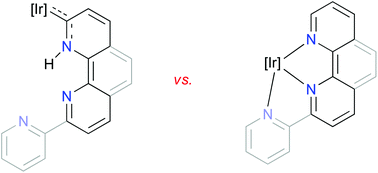
Dalton Trans., 2012,41, 14126-14136
https://doi.org/10.1039/C2DT31754K
Synthesis and structures of transition metal pacman complexes of heteroditopic Schiff-base pyrrole macrocycles
Macrocycles that combine pyrrole-imine and amine ether donor compartments form Ti, V, Cr, Co, and Pd complexes that adopt Pacman structures that facilitate the in-cleft binding of water through coordination and hydrogen bonds.
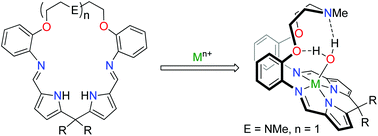
Dalton Trans., 2012,41, 13815-13831
https://doi.org/10.1039/C2DT31850D
Aqueous-phase hydroformylation of 1-octene using hydrophilic sulfonate salicylaldimine dendrimers
Preparation and characterization of water-soluble Rh(I) metallodendrimers. Hydroformylation under aqueous biphasic conditions is achieved at mild temperature and pressure. Good activities and selectivities are exhibited.
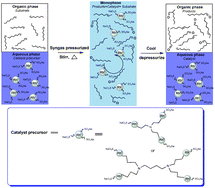
Dalton Trans., 2012,41, 13927-13935
https://doi.org/10.1039/C2DT31471A
Ligand effect on the catalytic activity of ruthenium nanoparticles in ionic liquids
Activity and selectivity of NP catalysts with size under 3 nm could be controlled by the σ-donor π-acceptor ligands as with a homogeneous catalyst.

Dalton Trans., 2012,41, 13919-13926
https://doi.org/10.1039/C2DT31644G
Ultrafast exciton dynamics in InAs/ZnSe nanocrystal quantum dots
Colloidal nanocrystal quantum dots with a band gap in the near infra-red have potential application as the emitters for telecommunications or in vivo imaging, or as the photo-absorbing species in next generation solar cells or photodetectors.
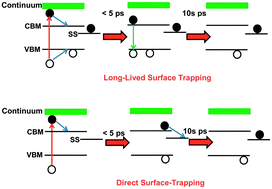
Phys. Chem. Chem. Phys., 2012,14, 15166-15172
https://doi.org/10.1039/C2CP42125A
Rhodium complexes stabilized by phosphine -functionalized phosphonium ionic liquids used as higher alkene hydroformylation catalysts : influence of the phosphonium headgroup on catalytic activity
Monodentate phosphine-functionalized phosphonium ionic liquids (PFILs) were employed as ligands for Rh complexes and used in the hydroformylation of higher alkenes.
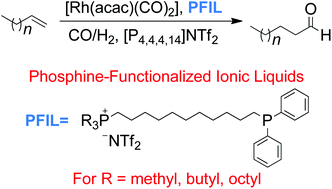
Dalton Trans., 2012,41, 13533-13540
https://doi.org/10.1039/C2DT31797D
Minimizing side reactions in chemoenzymatic dynamic kinetic resolution: organometallic and material strategies
Strategies for reducing the side-reactions of chemoenzymatic DKR: tuning the organometallic catalyst and entrapping the biocatalyst.
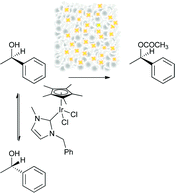
Dalton Trans., 2012,41, 13423-13428
https://doi.org/10.1039/C2DT31781H
Carboxylated polymers functionalized by cyclodextrins for the stabilization of highly efficient rhodium(0) nanoparticles in aqueous phase catalytic hydrogenation
Rhodium(0) nanoparticles stabilized by a water-soluble polymer catalyzed aqueous hydrogenation reaction.
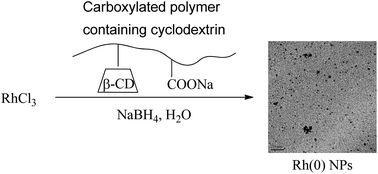
Dalton Trans., 2012,41, 13359-13363
https://doi.org/10.1039/C2DT31596C
Chiral Ag(I) and Pt(II) complexes of ditopic NHC ligands : synthesis, structural and spectroscopic properties
The platinum dinuclear complexes, cis-[Pt2(μ-NHC)(dmso)2Cl4], of ditopic chiral carbene ligands are reported. 1H, 13C, 195Pt and 1H–15N HMBC NMR data reveal the presence of rotamers in solution, arising from restricted rotation about the Pt–NHC bond.
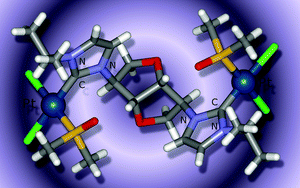
Dalton Trans., 2012,41, 12839-12846
https://doi.org/10.1039/C2DT31740K
Investigations on a series of novel ionic liquids containing the [closo-B12Cl12]2− dianion
A series of novel imidazolium, ammonium, phosphonium and pyridinium based salts with [closo-B12Cl12]2− dianion were synthesized by straight forward metathetic reactions and characterized by physical methods.
![Graphical abstract: Investigations on a series of novel ionic liquids containing the [closo-B12Cl12]2− dianion](/en/Image/Get?imageInfo.ImageType=GA&imageInfo.ImageIdentifier.ManuscriptID=C2RA21700G&imageInfo.ImageIdentifier.Year=2012)
RSC Adv., 2012,2, 9830-9838
https://doi.org/10.1039/C2RA21700G
[Pd(NHC)(PR3)] (NHC = N-heterocyclic carbene ) catalysed alcohol oxidation using molecular oxygen
A series of palladium(0) complexes bearing mixed phosphine/N-heterocyclic carbene supporting ligands are examined in aerobic oxidation of alcohols. These turn out to perform exceedingly well at low catalysts loadings under very mild conditions.
![Graphical abstract: [Pd(NHC)(PR3)] (NHC = N-heterocyclic carbene) catalysed alcohol oxidation using molecular oxygen](/en/Image/Get?imageInfo.ImageType=GA&imageInfo.ImageIdentifier.ManuscriptID=C2DT30133D&imageInfo.ImageIdentifier.Year=2012)
Dalton Trans., 2012,41, 12619-12623
https://doi.org/10.1039/C2DT30133D
Amidine - and amidinate-functionalised N-heterocyclic carbene complexes of silver and chromium
Diverse coordination modes are exhibited by the novel anionic amidinato NHC ligands.
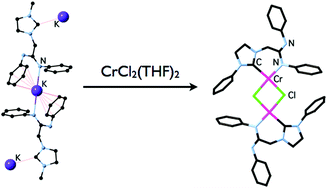
Dalton Trans., 2012,41, 12558-12567
https://doi.org/10.1039/C2DT31619F
Synthesis and catalytic application of palladium imidazol(in)ium-2-dithiocarboxylate complexes
The first organometallic and phosphine-based palladium complexes bearing NHC·CS2 ligands have been prepared in good yield. Low loadings of selected complexes were found to be highly active and selective pre-catalysts for oxidative C–H functionalisation.

Dalton Trans., 2012,41, 12386-12394
https://doi.org/10.1039/C2DT31413D
Variable coordination of a chiral diphosphine containing an amidinium/NHC group within its backbone: μ-P,P′, κ2-P,P′ and κ3-P,C,P′ coordination modes
An innately chiral diphosphine ligand with a central amidinium group shows variable coordination ranging from μ-bridging and κ2-binding through solely the phosphines to a κ3-mode upon release of the NHC donor with base. Conformational isomerism is observed in the complexes containing the tridentate ligand bound to Rh(I), Pd(II) and Pt(II).

Dalton Trans., 2012,41, 12395-12407
https://doi.org/10.1039/C2DT31475D
Molecular and electronic structures and photophysical properties of quadruply bonded dimetal complexes (M = Mo or W) supported by trans-arylethynylcarboxylate ligands where aryl = p-tolyl or 9-anthrancenyl
The title compounds shows interesting excited state charge delocalization and dynamics in S1 and T1 states as examined using fs and ns time-resolved UV-Vis and IR spectroscopy.

Dalton Trans., 2012,41, 12270-12281
https://doi.org/10.1039/C2DT31359F
Facile two-electron reduction of a closo-rhodathiadecaborane
Three new 10-vertex rhodathiaboranes are sequentially formed in the reaction between [arachno-4-SB8H11]− and [RhCl(PPh3)3]. This stepwise reactivity and the resulting closo → arachno → closo structural and electronic response augurs a rich chemistry.

Dalton Trans., 2012,41, 11627-11634
https://doi.org/10.1039/C2DT31465G
Coordination chemistry of diphenylphosphinoferrocenylthioethers on cyclooctadiene and norbornadiene rhodium(I) platforms
Compounds [RhCl(diene)(P,SR)] with chiral ferrocenyl phosphine–thioethers ligands preferentially adopt a neutral square planar structure with a dangling thioether as shown by a combination of 1H NMR, IR and DFT studies.

Dalton Trans., 2012,41, 11849-11859
https://doi.org/10.1039/C2DT30993A
Anion-dependent construction of two hexanuclear 3d–4f complexes with a flexible Schiff base ligand
Two new complexes with linear Eu4Cu2 or Eu4Ni2 cores are formed with a salen type Schiff base which caps each end of the metal chain.

Dalton Trans., 2012,41, 11449-11453
https://doi.org/10.1039/C2DT31268A
Synthesis and oxidation of d6 tungsten pincer complexes: a complete series of tungsten(II) hydridocarbonyl and halocarbonyl pincer complexes
Oxidation of d6 W(PHNP)(CO)3 gives a full series of cationic and neutral tungsten(II) hydridocarbonyls and halocarbonyls.
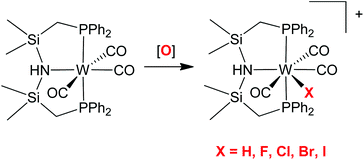
Dalton Trans., 2012,41, 11438-11448
https://doi.org/10.1039/C2DT30848G
N–H bond activation by palladium(II) and copper(I) complexes featuring a reactive bidentate PN-ligand
Backbone reactivity of a bidentate PN-ligand in the context of N–H activation leads to PdII and CuI amido complexes.
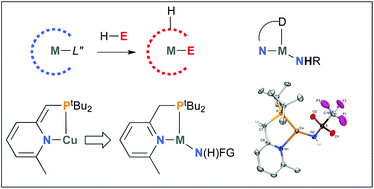
Dalton Trans., 2012,41, 11276-11283
https://doi.org/10.1039/C2DT31009K
TeX4 (X = F, Cl, Br) as Lewis acids – complexes with soft thio- and seleno-ether ligands
A systematic study of Te(IV) halide chemistry (halide = F, Cl or Br) with soft, neutral thio-, seleno- and telluroether ligands reveals significant coordination chemistry with the TeX4 Lewis acids, with clear boundaries between complexation and redox processes; NMR spectroscopic trends are reported and the distorted square pyramidal [TeF4(OPR3)] (R = Me or Ph) are included.
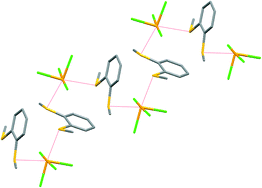
Dalton Trans., 2012,41, 10988-10999
https://doi.org/10.1039/C2DT30968H
Untethered 4,1,2-MC2B10 supraicosahedral metallacarboranes, their C,C′-dimethyl 4,1,6-, 4,1,8- and 4,1,12-MC2B10 analogues, and DFT study of the (4,)1,2- to (4,)1,6-isomerisations of C2B11 carboranes and MC2B10 metallacarboranes
Reduction and subsequent metallation of the tethered carborane shown affords both 4,1,2- and 4,1,6- MC2B-10 metallacarboranes by two quite separate routes.
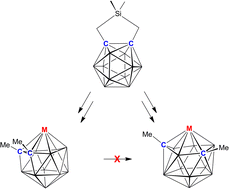
Dalton Trans., 2012,41, 10957-10969
https://doi.org/10.1039/C2DT31283B
Hydrogenolysis of β-O-4 lignin model dimers by a ruthenium-xantphos catalyst
In the presence of Ru(H)2(CO)(PPh3)(xantphos), under N2 or Ar, the alcohol function in lignin models is dehydrogenated. The ketone then undergoes C–O cleavage to form guaiacol and acetophenone derivatives; this hydrogenolysis also occurs readily under H2. When a –CH2– of the ketone is replaced by –CH(CH2OH)–, the catalysed hydrogenolysis is inhibited due to formation of characterised inactive Ru species.

Dalton Trans., 2012,41, 11093-11106
https://doi.org/10.1039/C2DT31065A
35/37Cl and 16/18O isotope resolved 195Pt NMR : unique spectroscopic ‘fingerprints’ for unambiguous speciation of [PtCln(H2O)6−n]4−n (n = 2–5) complexes in an acidic aqueous solution
The 128.8 MHz 195Pt NMR peaks of [Pt35/37Cln(H216/18O)6−n]n−2 (n = 2–6) complexes display unique 35/37Cl and 16/18O isotope resolved ‘fingerprints’ characteristic of the structure of the PtIV complexes, providing a novel method for unambiguous chemical speciation, particularly of the stereoisomers.
![Graphical abstract: 35/37Cl and 16/18O isotope resolved 195Pt NMR: unique spectroscopic ‘fingerprints’ for unambiguous speciation of [PtCln(H2O)6−n]4−n (n = 2–5) complexes in an acidic aqueous solution](/en/Image/Get?imageInfo.ImageType=GA&imageInfo.ImageIdentifier.ManuscriptID=C2DT31201H&imageInfo.ImageIdentifier.Year=2012)
Dalton Trans., 2012,41, 10533-10542
https://doi.org/10.1039/C2DT31201H
About this collection
We are delighted to present this collection of articles that have been dedicated to Professor David Cole-Hamilton, in celebration of his career.